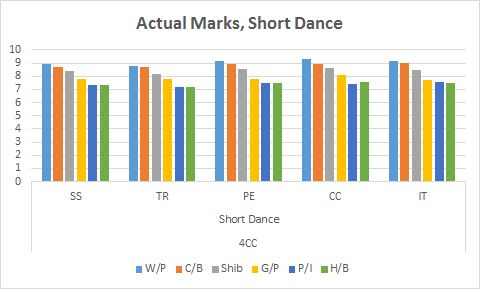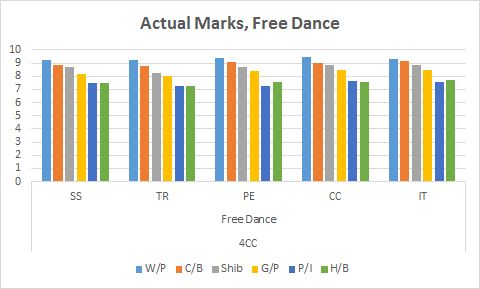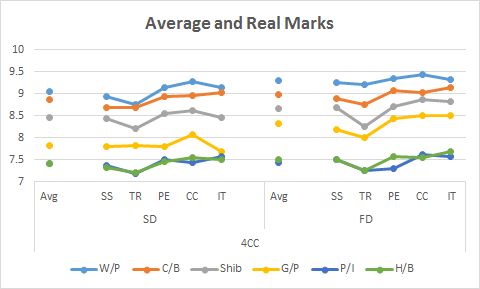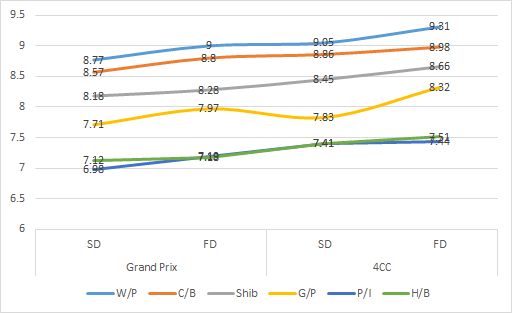With the Four Continents Championships (4CC) the first significant showdown among five of the six North American dance couples bound for Worlds (Madison Hubbell & Zach Donohue did not compete there, while Kaitlin Hawayek & Jean-Luc Baker will not compete in Shanghai), we’ll take a look now at how the judges assessed those teams against and within themselves — in category fashion. Each total program component score is, of course, the sum of averaged marks assigned by the judging panel across the five categories of Skating Skills, Transitions, Performance/Execution, Choreography/Composition and Interpretation/Timing, with general definitions and requirements for each found starting on page 27 here and in this USFSA guide.
It no doubt comes as little surprise to followers of this series that there is considerable consistency among the teams considered here — in every category, in every segment, at both 4CC and in an averaged set of Grand Prix event marks, the top four teams remain, in order, Kaitlyn Weaver & Andrew Poje, Madison Chock & Evan Bates, Maia & Alex Shibutani and Piper Gilles & Paul Poirier; only the marks for Alexandra Paul & Mitch Islam and Hawayek & Baker fluctuate. Likewise, range of distance between given teams by category in each segment at 4CC reflects this sense of continuity — though patterns change with the segment.
Short Dance
Skating Skills (SS): Paul/Islam, Hawayek/Baker (0.04, narrowest gap); Shibutani/Shibutani, Gilles/Poirier (0.64, widest)
Transitions (TR): Hawayek/Baker, Paul/Islam (0.03); Gilles/Poirier, Hawayek/Baker (0.61)
Performance/Execution (PE): Paul/Islam, Hawayek/Baker (0.04); Shibutani/Shibutani, Gilles/Poirier (0.75)
Choreography/Composition (CC): Hawayek/Baker, Paul/Islam (0.11); Shibutani/Shibutani, Gilles/Poirier (0.54)
Interpretation/Timing (IT): Paul/Islam, Hawayek Baker (0.07); Shibutani/Shibutani, Gilles/Poirier (0.78)
Free Dance
SS: Paul/Islam, Hawayek/Baker (0); Gilles/Poirier, Paul/Islam-Hawayek/Baker (0.68)
TR: Paul/Islam, Hawayek/Baker (0); Gilles/Poirier, Paul/Islam-Hawayek/Baker (0.75)
PE: Shibutani/Shibutani, Gilles/Poirier; Hawayek/Baker, Paul/Islam (0.28); Gilles/Poirier, Hawayek/Baker (0.86)
CC: Paul/Islam, Hawayek/Baker (0.07); Gilles/Poirier, Paul/Islam (0.89)
IT: Hawayek/Baker, Paul/Islam (0.11); Gilles/Poirier, Hawayek/Baker (0.82)
Our earlier article exploring component marks at the 2014 Olympics and Worlds indicated that range between any set of marks for a team tends to be narrow, even for those teams facing less of a judging consensus. To that end, then, an average component mark of, for example, 9.05 for Weaver & Poje in the 4CC short dance is not far removed from any of the five real marks assigned at that event. Still, certain trends in this vein can also be observed — such as the fact that every couple’s SS and TR marks in that short were below their average, CC above it. This pattern carried through with respect to TR and CC in the FD, where IT also saw a boost.
The minimal and maximal individual deviations by category, meanwhile:
Short Dance
Skating Skills: Shibutani/Shibutani (-0.02); Chock/Bates (-0.18)
Transitions: Gilles/Poirier (-0.01); Weaver/Poje (-0.3)
Performance/Execution: Gilles/Poirier (-0.07); Weaver/Poje, Shibutani/Shibutani, Paul/Islam (+0.09)
Choreography/Composition: Paul/Islam (+0.02); Weaver/Poje, Gilles/Poirier (+0.24)
Interpretation/Timing: Shibutani/Shibutani (+0.01); Chock/Bates (+0.18)
Free Dance
SS: Hawayek/Baker (-0.01); Gilles/Poirier (-0.14)
TR: Weaver/Poje (-0.1); Shibutani/Shibutani (-0.41)
PE: Weaver/Poje, Shibutani/Shibutani (+0.05); Paul/Islam (-0.15)
CC: Hawayek/Baker (+0.03); Shibutani/Shibutani (+0.2)
IT: Weaver/Poje (+0.01); Gilles/Poirier (+0.18)
And per team, by segment:
Weaver/Poje
Short dance: PE, IT (+0.09); TR (-0.3)
Free dance: IT (+0.01); CC (+0.12)
Chock/Bates
Short dance: PE (+0.07); SS, TR (-0.18), IT (0.18)
Free dance: CC (+0.06); TR (-0.23)
Shibutani/Shibutani
Short dance: IT (+0.01); TR (-0.24)
Free dance: SS (+0.02); TR (-0.41)
Gilles/Poirier
Short dance: TR (-0.01); CC (+0.24)
Free dance: PE (+0.11); TR (-0.32)
Paul/Islam
Short dance: CC (+0.02); TR (-0.23)
Free dance: SS (+0.06); TR (-0.19)
Hawayek/Baker
Short dance: PE (+0.05); TR (-0.2)
Free dance: SS (-0.01); TR (-0.26)
The Grand Prix marks provided in the spreadsheet are averages of marks assigned at each couple’s Grand Prix events, including the Grand Prix Final in the case of Weaver & Poje, Chock & Bates, Shibutani & Shibutani and Gilles & Poirier. That data, then, cannot be assessed so minutely as that for 4CC has. It does, however, serve quite well as the basis for a broad comparative analysis.
From short dance to free dance at 4CC, every team saw some percentage of growth. For Paul & Islam, who experienced a fall in the free, that growth was limited to 0.4%. For Gilles & Poirier, whose short dance saw its own errors, that increase was a dataset-high 6.3%.
But some significant expansion also occurred from the Grand Prix to 4CC. Average growth in the short dance was 3.6%, with most couples falling near that rate; for the aforementioned Canadians, however, fortunes were rather reversed: while Gilles & Poirier’s mark only increased by 1.6%, Paul & Islam’s grew by 6.2%. The free dance saw less dramatic spikes, with no significant deviations from an average of 3.75%. An increase of 2% for Chock & Bates was the low outlier, while 4.6% from both the Shibutanis and Hawayek & Baker was a high.
Most curiously, perhaps, is the case of total growth: not only did short dance marks and free dance marks alone increase from the Grand Prix average to 4CC, but short dance marks at 4CC were in all but one case themselves increased from even free dance marks on the Grand Prix. The one exception falls to Gilles & Poirier, whose 4CC short dance average of 7.83 showed a 0.14 decline from the Grand Prix free dance average.
This data is not necessarily predictive of what may come at Worlds, especially in the absence of the wild card Hubbell & Donohue, whose close results with Gilles & Poirier on the Grand Prix and additional mileage since may present a shake-up. It does, however, reveal that at even the most minute of levels, movement is minimal.




